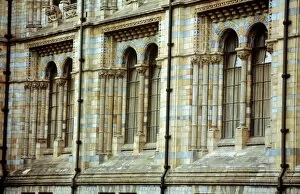The Waterhouse Building Collection (page 4)
"The Waterhouse Building: A Timeless Tribute to Natural History" Step into the magnificent world of The Waterhouse Building
All Professionally Made to Order for Quick Shipping
"The Waterhouse Building: A Timeless Tribute to Natural History" Step into the magnificent world of The Waterhouse Building, a historic landmark that stands as a testament to the wonders of natural history. Designed by renowned architect Alfred Waterhouse, this architectural masterpiece has captivated visitors since its inception in 1872. As you enter through the grand entrance, prepare to be transported back in time. The Geological Gallery, established in 1892, showcases an impressive collection of fossils and minerals. Here, you can marvel at the skeletal remains of prehistoric creatures like the Giant Ground Sloth, reminding us of Earth's ancient inhabitants. Venturing further into this treasure trove of knowledge is the Coral Gallery from c. 1895. Immerse yourself in vibrant displays that depict coral reefs teeming with life and learn about their ecological importance. The heart and soul lies within its Central Hall – a breathtaking space that exudes grandeur and elegance. Originally constructed in 1882 and later expanded in 1902, it serves as a focal point for visitors to gather and admire the museum's vast collections. Make your way up to East Gallery on the first floor where you'll encounter captivating exhibits showcasing diverse ecosystems from around the globe. From lush rainforests to arid deserts, each display offers an immersive experience that educates and inspires visitors about our planet's rich biodiversity. Stroll along West Corridor which dates back to 1882; here you'll find meticulously curated galleries housing fascinating artifacts that tell stories spanning millions of years. Take a moment to appreciate how these exhibits have stood the test of time while continuing to educate generations after generations. No visit would be complete without encountering some remarkable animal specimens within The Fossil Mammal Gallery or catching sight of graceful Gazelles gracefully displayed throughout various sections - including Thomsons Gazelles - bringing nature's beauty indoors for all to enjoy.















